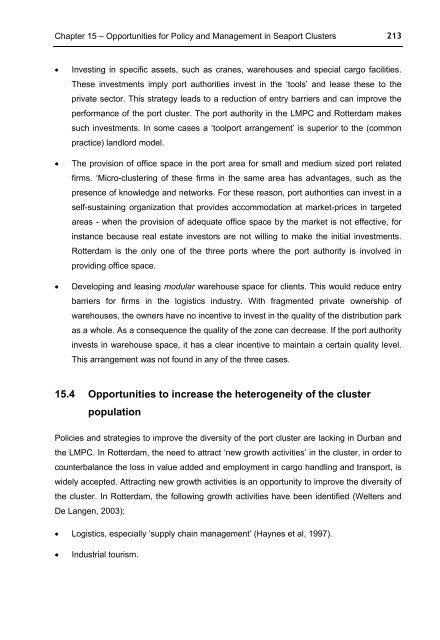The Performance of Seaport Clusters - RePub - Erasmus Universiteit ...
The Performance of Seaport Clusters - RePub - Erasmus Universiteit ...
The Performance of Seaport Clusters - RePub - Erasmus Universiteit ...
You also want an ePaper? Increase the reach of your titles
YUMPU automatically turns print PDFs into web optimized ePapers that Google loves.
Chapter 15 – Opportunities for Policy and Management in <strong>Seaport</strong> <strong>Clusters</strong> 213<br />
• Investing in specific assets, such as cranes, warehouses and special cargo facilities.<br />
<strong>The</strong>se investments imply port authorities invest in the ‘tools’ and lease these to the<br />
private sector. This strategy leads to a reduction <strong>of</strong> entry barriers and can improve the<br />
performance <strong>of</strong> the port cluster. <strong>The</strong> port authority in the LMPC and Rotterdam makes<br />
such investments. In some cases a ‘toolport arrangement’ is superior to the (common<br />
practice) landlord model.<br />
• <strong>The</strong> provision <strong>of</strong> <strong>of</strong>fice space in the port area for small and medium sized port related<br />
firms. ‘Micro-clustering <strong>of</strong> these firms in the same area has advantages, such as the<br />
presence <strong>of</strong> knowledge and networks. For these reason, port authorities can invest in a<br />
self-sustaining organization that provides accommodation at market-prices in targeted<br />
areas - when the provision <strong>of</strong> adequate <strong>of</strong>fice space by the market is not effective, for<br />
instance because real estate investors are not willing to make the initial investments.<br />
Rotterdam is the only one <strong>of</strong> the three ports where the port authority is involved in<br />
providing <strong>of</strong>fice space.<br />
• Developing and leasing modular warehouse space for clients. This would reduce entry<br />
barriers for firms in the logistics industry. With fragmented private ownership <strong>of</strong><br />
warehouses, the owners have no incentive to invest in the quality <strong>of</strong> the distribution park<br />
as a whole. As a consequence the quality <strong>of</strong> the zone can decrease. If the port authority<br />
invests in warehouse space, it has a clear incentive to maintain a certain quality level.<br />
This arrangement was not found in any <strong>of</strong> the three cases.<br />
15.4 Opportunities to increase the heterogeneity <strong>of</strong> the cluster<br />
population<br />
Policies and strategies to improve the diversity <strong>of</strong> the port cluster are lacking in Durban and<br />
the LMPC. In Rotterdam, the need to attract ‘new growth activities’ in the cluster, in order to<br />
counterbalance the loss in value added and employment in cargo handling and transport, is<br />
widely accepted. Attracting new growth activities is an opportunity to improve the diversity <strong>of</strong><br />
the cluster. In Rotterdam, the following growth activities have been identified (Welters and<br />
De Langen, 2003):<br />
• Logistics, especially ‘supply chain management’ (Haynes et al, 1997).<br />
• Industrial tourism.

















